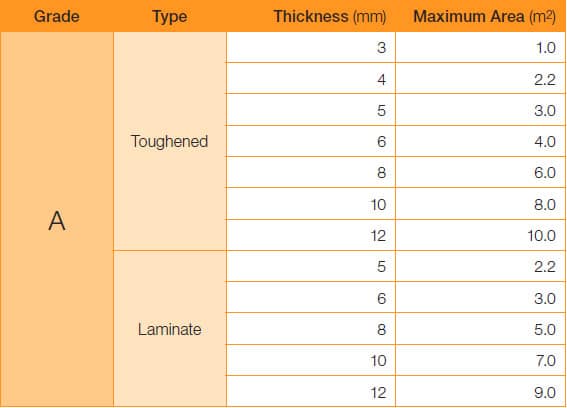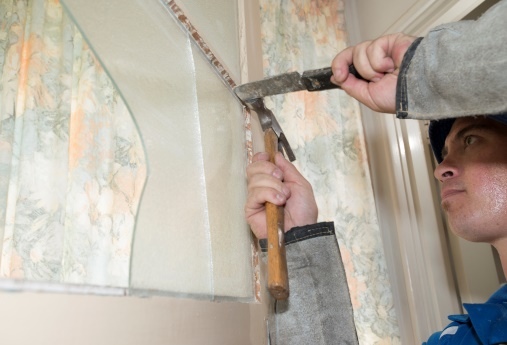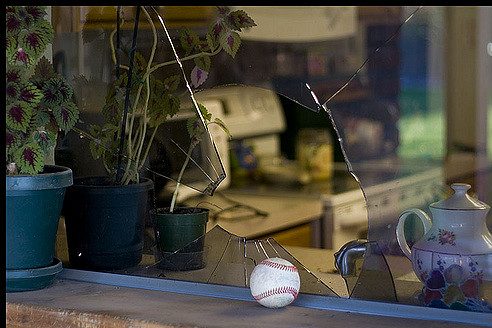All glass installed in buildings shall comply with relevant Australian Standards. It is strongly recommended that builders, architects, building designers and building surveyors ensure evidence is provided. Marking of glass to ensure compliance to AS2208 is mandatory.
The use of monolithic toughened glass more than 5000mm above finished floor height may be at risk of spontaneous breakage. Toughened glass glazed monolithically should be heat soaked unless a barrier exists which will revert the fragments from falling and reduce the risk of injury.
An awning or a balcony would be considered a barrier which suits this purpose. Please refer to AS1288 for further clarification.
1. Doors
- Small panels in doors 3mm and 4mm annealed glass is permitted to a maximum of 0.1m2 and a maximum panel width of 125mm.
- Small panels in doors 5mm and 6mm annealed glass is permitted to a maximum of 0.26 m2 with a maximum panel width of 300mm
- Unframed doors other than those in bathrooms shall be glazed with toughened safety glass with a minimum of 10mm thickness.
2. Side Panels (Glass which has its vertical sight line within 300mm of door opening)
- A minumum of 5mm ordinary annealed glass may be used up to a maximum area of 0.3 m2
- For decorated glass 3mm and 4mm glass shall not exceed 0.1m2 to a maximum panel width of 125mm.
- For decorated glass 5mm and 6mm glass shall not exceed 0.26m2 to a maximum panel width of 300mm.
- Grade A Safety glass to TABLE 5.1 if the panel is within 1200mm from floor or ground level and fully framed.
3. Windows (Low Lights)
All low level glazing where the lowest sight line is less than 500mm from the ground or floor level shall be Grade A safety glass to Table 5.1 except:
in fully framed glazing ordinary annealled glass not less than 5mm is permitted to a maximum area of 1.2 m2. Larger areas of ordinary annealed glass are not permitted regardless of glass thickness.
4. Glass which could be mistaken for a doorway or opening.
Ask yourself “could anyone mistake the panel for a doorway or opening ans potentially walk into the glass”?
If yes, use Grade A safety glass
***NOTE: The panel cannot be mistaken IF:
- Opening is equal to or less than 500mm wid.
- Lowest sight line is 500mm above the floor
- The sight size height is less than 1000mm
- The glazing is opaque or patterned
- A chair rail is provided with its upper edge not less than 700mm and its top edge not more than 1000mm above the floor level.
- The panels are louvres with a blade width not greater than 230mm
- A difference in floor level of 1000mm
5. Bathrooms
All Glass in bathrooms should use Grade A or B safety glass for fully framed glazing. The only exception being a mirror, which is either fully adhered to the wall or fully protected by a vanity or bench with a minimum height of 760mm and a minimum depth of 300mm.
- Partly framed glazing shall be glazed with Grade A Safety Glass with a minimum thickness of 5mm to an area not exceeding 2.2m3
- Frameless glazing in shower screen doors and returns shall be Grade A toughened or toughened laminate with a minimum thickness of 6mm.
6. Louvre blades subject to risk of human impact
Where Grade A safety glass is required and louvres are used, those louvres shall be Grade A toughened safety glass. A nominal thickness of 5mm up to 230mm in blade width and 1000mm in blade length ie: bathrooms, side panels, aged care and schools.
7. Two Edge Unframed Glazing
Glazing with two horizontal edges unframed shall be Grade A safety glass and comply with the following.
- 5mm toughened to a maximum 1000mm span
- 6mm toughened to a maximum 1200mm span
- 6.38mm laminated to a maximum 750mm span
8. Stairway Glazing
Glazing including mirrors in stairways, shall be Grade A safety glass in the following situations:
- Within 2000mm horizontally and at right angles to the bottom riser of each stair flight.
- Withing 1000mmm and parallel to any part of the stair flight or landing.
- Safety glass is not required where the glazing is protected by a solid barrier not less than 1000mm in height.
9. Making Glass Visible
If the presence of glass is not made visible in a door, side panel or a panel capable of being mistaken for a doorway or opening and is not made apparent by other means, the glass shall be marked to make it visible.
Marking shall be in the form of an opaque band not less than 20mm in height and located so that the vertical height from the floor level is:
- Not less than 700mm from the upper edges of the band and
- Not more than 1200mm to the lower edge of the band.
Making glass visible is not a substitute for safety glazing.

NOTE: Toughened laminate can be substituted where toughened is required.
10. Balustrades
All balustrades require an interlinking hand rail where the difference in floor level is greater than 1000mm.
Glass in balustrades which have a load supporting handrail and use glass infill panels at 1.0kPa and 0.50kN, which are framed on two opposite sides or are fully framed on all four edges, shall be a minimum of 8mm toughened to a maximum span of 1070mm between supports.
10mm toughened to a maiximum span of 1650mm supports. 12mm toughened to a maximum span of 1930mm between supports.
Span is defined as the distance between supports. For glass supported on all four edges, span is the smaller dimension.
PLEASE NOTE
- This guide applies to glass that has a maximum wind load of 1.5 ULS and .80 SLS and an aspect ratio not greater than 4.
- It only applies where panels are supported on 4 sides (except where indicated)
- This guide applies to glass that is within 2000mm of ground or floor level
Disclaimer: This post has been developed to provide general guidance, awareness and education. It should not be viewed as a definitive guide. While every effort has been made to ensure all information is accurate True Blue Glass expressly disclaims all and any liability to any person for anything done in reliance on this publication.
No responsibility is accepted by True Blue Glass for any mistakes, errors or omissions in this publication.

It is fair to say that being a glazier probably causes a few confused looks when you tell some one what trade you are in but being a glazier means you have to have a wide range of knowledge and expertise.
So glaziers are tradies that deal with all aspects of glass supply, repair and installation.
With specially designed architectural designed homes on the rise it has created a greater use of glass to create the dream of the owners.
This in turn has made the glazing trade evolve and all glaziers new and old have had adapt as its no longer good enough to just be doing “hack outs” which is the term for “hacking” out broken glass and replacing with new glass.
Glaziers now specialise in all different types of glass applications which is why making sure customers need to make sure they are getting a reputable and knowledge company when replacing there glass or installing a new shower in their home.
For the older generation if you think of your family home now compared to when you were younger, we had smaller windows which were generally double hung windows. Internally would mostly just be a cabinet mirror in the bathroom and that’s about it.
Now glass makes up almost 30% of our external cladding including big picture windows, glass sliding doors and glass balustrading.
Internally we have kitchen splash backs, huge mirrors in our bathrooms and internal glass doors throughout.
So really the question is not “What do Glaziers do?” but should be “What do I want my Glazier to do?”.
Glass Splashbacks – can come in almost any colour you can think of. And with advances in technology and design you can even get glass splashbacks with imbedded graphic designs.
Glass Balustrades – for pool surrounds, decking and stairwells can add a clean and spacious feel to an area.
Showerscreens repair & new installations– there are so many choices when it comes to shower screens including framed, semi-frameless and frameless. We can also service and repair your existing shower screen.
Glass Tabletops & Shelving – glass tabletops can be used to protect timber or marble surfaces or can be the table top itself. Tabletops that not fully supported should be Grade A toughened safety glass. Glass used to protect a surface may only be in ordinary float glass.
Glass Replacement – repair of broken windows and glass in doors.

Mirrors – Mirrors are often features in bathroom to bring in light and add bring a contemporary feel.
Pet Door Installations – we all love our pets and by adding a pet door to your glass window or door we can provide easy access in and out of the house.
External Cladding – often includes high rise glazing and requires a whole unique skill set.
Commercial shopfronts and Commercial Fit outs – think retail shops and all the glass required to fit it out. This could include curved glass, shelving, mirrors and internal partitions.
Install new aluminium doors and window Glazing – This is glazing new frames -timber, aluminum or steel.
Architectural Glazing Features – such as slumped glass and lead lighting as well as specialised coloured glass and often involves aluminium fabrication.
Double Glazing – or Insulated Glazing Units which are so prevalent now that it’s almost standard in all new homes being built in Queensland.
Supply & install new security screens to doors windows – Install extra security around the home by getting fly screens or security screens to your windows and doors around the home.
Window Tinting – Reduce the amount of heat coming into the home by tinting your windows.
Windows bring natural light and fresh air into our homes as well as offering views that connect the inside to the outdoors.
However, window-related accidents and security can be a major source of concern.
Especially for small children which means that putting safety glass in your home can be very important.
Fortunately, there are a number of preventative measures you can take to improve the safety risks of your home.
By arming yourself with the right knowledge, you can have greater peace of mind for the safety of you and your family.
Safety glass areas of a home that are prone to accidents are required to be fitted with what’s known as Grade A safety glass.
The use of safety glass reduces the risk of injury as it is tougher to break and won’t fracture into dangerous shards if broken.
In recent years the areas of your home where safety glass is required has increased, while the allowances for ordinary glass areas has decreased.
Putting safety glass in your home – areas where it should be installed
As a general guide you must use safety glass in:
- all glass doors
- bathrooms (for all areas up to 2 metres high)
- door side panels (if less than 300mm away from the door and positioned 1.2 meters or less above the floor)
- around stairs (for a distance of 1 meter from either side of the stairs and 2 meters from the bottom of the stairs)
- areas that can be mistaken for openings (e.g. full height glass)
- low level glass (if larger than 1.2 metres – areas under 1.2 metres require a minimum of 5mm thick glass
- throughout your home if you are running a childcare business.
While these are the minimum areas that require safety glass you may want to consider using it in additional spaces, especially where children are active.
There are two types of safety glass available – toughened glass and laminated glass.
Alternatively, glass safety film can be applied to existing windows and glass areas.
While laminated glass, toughened glass and window film can all be used to meet Australian building regulations
It is worth selecting the most appropriate one to meet your needs
If you would like to read more information regarding the differences between toughened and laminated glass, click on the link below:




